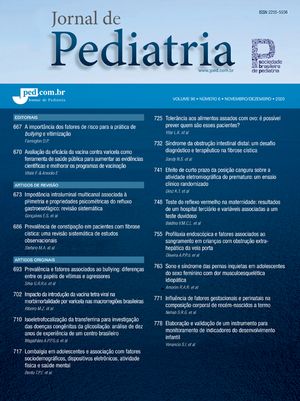
Otitis media is the most frequently diagnosed infection in the pediatric office. Ninety per cent of the children present at least one episode of otitis media before the fifth birthday. We reviewed the literature in order to update information regarding the current definitions of acute otitis media, recurrent otitis media and otitis media with effusion, analyzing the predisposing factors, microbiology, clinical manifestations, diagnostic criteria and methods of treatment for these entities, and the relationship between otitis media and language development and learning disabilities.
Data sourceBibliographic review of an eighteen- year period (1980-1998) using Index Medicus and Medline.
Results and conclusionsMore than 25 million diagnoses per year of middle ear infections are made in the United States, being responsible for rising costs of treatment. The role of many predisposing factors is presently well recognized and we should be capable of defining interventions related to some of them as is the case of early institution of day-care, short duration of breast feeding and difficulties in the identification and treatment of gastroesophageal reflux. Changes in the microbiology of the middle ear infections and the emergence of multiresistant bacteria leads to modifications in antibiotic therapy and the duration of its use. Antibacterial agents should be prescribed only in the presence of a well-defined diagnosis and chemoprophylaxis should be avoided. Recurrent otitis media and otitis media with effusion in infants may be associated to speech disorders and learning disabilities. The development of a conjugated vaccine against S. pneumoniae and the experiments with a vaccine against non-typeable H. influenzae represent a big step in the prevention of infections of the middle ear for the near future.
A otite média é a infecção mais freqüentemente diagnosticada pelos pediatras. Noventa por cento das crianças têm pelo menos um episódio de otite média antes de completar cinco anos de idade. O objetivo desta revisão é fornecer uma visão atualizada da patologia, definindo os conceitos de otite média aguda, recorrente e secretora, analisando os diversos fatores de risco, a microbiologia, as manifestações clínicas, os critérios para diagnóstico, as peculiaridades do tratamento e a relação entre otite média e retardo na aquisição da linguagem / distúrbio de aprendizagem.
Origem dos dadosLevantamento bibliográfico no período de 1980 - 1998 através do Index Medicus e Medline.
Síntese dos dados e conclusõesAs infecções da orelha média representam mais de 25 milhões de diagnósticos/ano nos EUA e seguem aumentando, envolvendo custos elevados no tratamento. O papel de vários fatores predisponentes está devidamente reconhecido, entre eles alguns modificáveis por nós, como a entrada precoce nas creches, o desmame prematuro e o refluxo gastresofágico não identificado. A modificação do perfil das bactérias causadoras de infecção da orelha média e a emergência de cepas multirresistentes implica na reformulação das indicações de antibioticoterapia e duração da sua utilização. O antibacteriano deve ser empregado somente quando houver certeza do diagnóstico e deverá ter seu uso profilático evitado. A otite média recorrente e a otite média secretora antes dos três anos de idade podem levar a retardo na aquisição da linguagem e a distúrbios de aprendizagem. A vacina contra H. influenzae não encapsulado e a vacina conjugada contra o S. pneumoniae representarão, num futuro próximo, um grande avanço na prevenção da infecção da orelha média.










